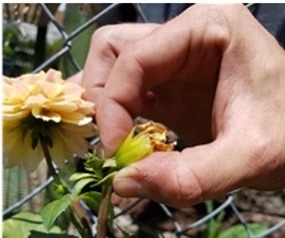When you hear the word “deadhead,” you may think of your crazy Uncle Ernie who still tie-dyes his socks, but “deadhead” has a special meaning to gardeners.
To “deadhead” is to remove the wilted, dead blossoms from annuals and perennials. This helps the plant bloom more and for a longer time. The whole purpose of flowers in nature is to produce seeds so the plant can reproduce. In many cases, once the flower has done its job and gone to seed, the plant will stop producing blooms and focus its energy elsewhere. But if you pinch off the old flowers before that, the plant will try again and again to make those seeds – filling your plants with even more beautiful blossoms!
 As soon as the blooms start to fade, just pinch the spent blossoms off right where the flower meets the stem. This will stop the flower from making seeds and encourage the plant to produce brand new blossoms. Sometimes, especially on flowers that bloom in spikes or on long stems, this can leave an unsightly bare stalk sticking out. In that case, just trim the stem down to the first leaf below the old flower head. This will keep the plant looking tidy and won’t affect its growth at all.
As soon as the blooms start to fade, just pinch the spent blossoms off right where the flower meets the stem. This will stop the flower from making seeds and encourage the plant to produce brand new blossoms. Sometimes, especially on flowers that bloom in spikes or on long stems, this can leave an unsightly bare stalk sticking out. In that case, just trim the stem down to the first leaf below the old flower head. This will keep the plant looking tidy and won’t affect its growth at all.
To some gardeners, deadheading is a labor of love. To others, it’s a chore. If you fall into the later camp, there are many varieties of sterile annuals that are “self-cleaning.” These plants can’t produce seeds, but they still keep trying, pushing out as many new flowers as they can. The old flowers drop off by themselves and are followed quickly by new ones. For these plants, deadheading isn’t necessary, but it won’t hurt them either. So either way, pluck away!
This season, deadhead your garden to increase your flower power. You’ll be Grateful you did, man…

